#PHP components
Explore tagged Tumblr posts
Text
Back-End Developer
An IT Services back-end developer, under our brand name, is tasked with constructing and upholding the server-side components of web applications and software.
0 notes
Text
SysNotes devlog 1
Hiya! We're a web developer by trade and we wanted to build ourselves a web-app to manage our system and to get to know each other better. We thought it would be fun to make a sort of a devlog on this blog to show off the development! The working title of this project is SysNotes (but better ideas are welcome!)

What SysNotes is✅:
A place to store profiles of all of our parts
A tool to figure out who is in front
A way to explore our inner world
A private chat similar to PluralKit
A way to combine info about our system with info about our OCs etc as an all-encompassing "brain-world" management system
A personal and tailor-made tool made for our needs
What SysNotes is not❌:
A fronting tracker (we see no need for it in our system)
A social media where users can interact (but we're open to make it so if people are interested)
A public platform that can be used by others (we don't have much experience actually hosting web-apps, but will consider it if there is enough interest!)
An offline app
So if this sounds interesting to you, you can find the first devlog below the cut (it's a long one!):
(I have used word highlighting and emojis as it helps me read large chunks of text, I hope it's alright with y'all!)
Tech stack & setup (feel free to skip if you don't care!)
The project is set up using:
Database: MySQL 8.4.3
Language: PHP 8.3
Framework: Laravel 10 with Breeze (authentication and user accounts) and Livewire 3 (front end integration)
Styling: Tailwind v4
I tried to set up Laragon to easily run the backend, but I ran into issues so I'm just running "php artisan serve" for now and using Laragon to run the DB. Also I'm compiling styles in real time with "npm run dev". Speaking of the DB, I just migrated the default auth tables for now. I will be making app-related DB tables in the next devlog. The awesome thing about Laravel is its Breeze starter kit, which gives you fully functioning authentication and basic account management out of the box, as well as optional Livewire to integrate server-side processing into HTML in the sexiest way. This means that I could get all the boring stuff out of the way with one terminal command. Win!
Styling and layout (for the UI nerds - you can skip this too!)
I changed the default accent color from purple to orange (personal preference) and used an emoji as a placeholder for the logo. I actually kinda like the emoji AS a logo so I might keep it.
Laravel Breeze came with a basic dashboard page, which I expanded with a few containers for the different sections of the page. I made use of the components that come with Breeze to reuse code for buttons etc throughout the code, and made new components as the need arose. Man, I love clean code 😌
I liked the dotted default Laravel page background, so I added it to the dashboard to create the look of a bullet journal. I like the journal-type visuals for this project as it goes with the theme of a notebook/file. I found the code for it here.
I also added some placeholder menu items for the pages that I would like to have in the app - Profile, (Inner) World, Front Decider, and Chat.

i ran into an issue dynamically building Tailwind classes such as class="bg-{{$activeStatus['color']}}-400" - turns out dynamically-created classes aren't supported, even if they're constructed in the component rather than the blade file. You learn something new every day huh…

Also, coming from Tailwind v3, "ps-*" and "pe-*" were confusing to get used to since my muscle memory is "pl-*" and "pr-*" 😂
Feature 1: Profiles page - proof of concept
This is a page where each alter's profiles will be displayed. You can switch between the profiles by clicking on each person's name. The current profile is highlighted in the list using a pale orange colour.

The logic for the profiles functionality uses a Livewire component called Profiles, which loads profile data and passes it into the blade view to be displayed. It also handles logic such as switching between the profiles and formatting data. Currently, the data is hardcoded into the component using an associative array, but I will be converting it to use the database in the next devlog.

New profile (TBC)
You will be able to create new profiles on the same page (this is yet to be implemented). My vision is that the New Alter form will unfold under the button, and fold back up again once the form has been submitted.
Alter name, pronouns, status
The most interesting component here is the status, which is currently set to a hardcoded list of "active", "dormant", and "unknown". However, I envision this to be a customisable list where I can add new statuses to the list from a settings menu (yet to be implemented).




Alter image
I wanted the folder that contained alter images and other assets to be outside of my Laravel project, in the Pictures folder of my operating system. I wanted to do this so that I can back up the assets folder whenever I back up my Pictures folder lol (not for adding/deleting the files - this all happens through the app to maintain data integrity!). However, I learned that Laravel does not support that and it will not be able to see my files because they are external. I found a workaround by using symbolic links (symlinks) 🔗. Basically, they allow to have one folder of identical contents in more than one place. I ran "mklink /D [external path] [internal path]" to create the symlink between my Pictures folder and Laravel's internal assets folder, so that any files that I add to my Pictures folder automatically copy over to Laravel's folder. I changed a couple lines in filesystems.php to point to the symlinked folder:

And I was also getting a "404 file not found" error - I think the issue was because the port wasn't originally specified. I changed the base app URL to the localhost IP address in .env:

…And after all this messing around, it works!
(My Pictures folder)

(My Laravel storage)

(And here is Alice's photo displayed - dw I DO know Ibuki's actual name)

Alter description and history
The description and history fields support HTML, so I can format these fields however I like, and add custom features like tables and bullet point lists.

This is done by using blade's HTML preservation tags "{!! !!}" as opposed to the plain text tags "{{ }}".
(Here I define Alice's description contents)


(And here I insert them into the template)

Traits, likes, dislikes, front triggers
These are saved as separate lists and rendered as fun badges. These will be used in the Front Decider (anyone has a better name for it?? 🤔) tool to help me identify which alter "I" am as it's a big struggle for us. Front Decider will work similar to FlowCharty.

What next?
There's lots more things I want to do with SysNotes! But I will take it one step at a time - here is the plan for the next devlog:
Setting up database tables for the profile data
Adding the "New Profile" form so I can create alters from within the app
Adding ability to edit each field on the profile
I tried my best to explain my work process in a way that wold somewhat make sense to non-coders - if you have any feedback for the future format of these devlogs, let me know!
~~~~~~~~~~~~~~~~~~
Disclaimers:
I have not used AI in the making of this app and I do NOT support the Vibe Coding mind virus that is currently on the loose. Programming is a form of art, and I will defend manual coding until the day I die.
Any alter data found in the screenshots is dummy data that does not represent our actual system.
I will not be making the code publicly available until it is a bit more fleshed out, this so far is just a trial for a concept I had bouncing around my head over the weekend.
We are SYSCOURSE NEUTRAL! Please don't start fights under this post
#sysnotes devlog#plurality#plural system#did#osdd#programming#whoever is fronting is typing like a millenial i am so sorry#also when i say “i” its because i'm not sure who fronted this entire time!#our syskid came up with the idea but i can't feel them so who knows who actually coded it#this is why we need the front decider tool lol
24 notes
·
View notes
Text
okee my performance eval is in my portal so i wanted to make a little thing i can reference when i'm Going Through It...i'm not putting my worth in my job, trust me, but some of these compliments are just...they're a lot more thoughtful than "she works hard" lol
here's some copy/pasted quotes in no particular order, starting with some project-specific stuff:
Her adaptability, technical initiative and rapid progress were critical to delivering a fully functioning, design system-based theme that will be used campus-wide. Her efforts were essential to the success of this project.
Not only did [NAME] help deliver the core WordPress theme with no prior experience in PHP, but she simultaneously designed and help develop a child theme specifically for the [REDACTED] site. She was able to manage this while the content for the [REDACTED] site was still in flux, requiring her to adapt quickly to evolving design, front-end and backend needs. Despite these shifting requirements and tight deadlines, [NAME] consistently delivered high-quality, pixel-perfect design comps, implemented front-end CSS and executed backend integration when needed with impressive speed and efficiency.
[NAME] has demonstrated exceptional performance and leadership in her role and is the primary contributor to the design system. Among a team of five contributors, she has resolved more than 65% of all GitHub tickets, including both bugs and feature requests. Her involvement spans the full product lifecycle--contributing to ideation, design, front-end development with pixel precision, and CMS integration.
and here's some general comments:
[NAME] has been a critical asset to the success of the team by leading the design and being a lead developer for the [REDACTED] UX Web Design System and related projects. She has maintained the design and front-end development of system components, maintained the Figma library and provided consistent support to campus teams through training, documentation and office hours. Despite no prior experience in PHP, she quickly learned and contributed significantly to building and launching the WordPress theme and a custom [REDACTED] child theme. Her strong work ethic, adaptability and attention to detail ensured high-quality, accessible and brand-compliant work under tight deadlines. [NAME]'s impact has been campus-wide and her contributions have been instrumental in advancing design system adoption and execution.
[NAME] demonstrates a strong sense of accountability by taking full ownership of her work and consistently delivering high-quality results. She follows through on commitments, meets deadlines even under tight timelines and holds herself to a high standard of accuracy and consistency--particularly in design, accessibility, usability and brand compliance. Her reliability has made her a go-to team member on high-impact projects, and her attention to detail ensures that nothing falls through the cracks.
[NAME] consistently demonstrates initiative by proactively identifying needs, taking ownership of complex tasks and delivering high-quality work with minimal supervision. She exceeded expectations by independently learning PHP to contribute to backend development and took the lead on critical design system components without being asked. Her ability to self-direct, anticipate challenges and follow through has made her a reliable and trusted contributor across every phase of a project.
and the overall comment/rating:
[NAME] has consistently exceeded expectations in her role, demonstrating exceptional initiative and accountability. As the lead developer to the [REDACTED] UX Web Design System, she has driven the design, development and support of system components with precision and care, resolving more than 65% of all GitHub tickets. Her proactive approach, technical adaptability and attention to accessibility and usability have made her indispensable to both the internal team and the broader campus community. She takes full ownership of her work, delivers high-quality results with minimal supervision and regularly supports others. Her impact is visible across every facet of the project lifecycle-from frontend and backend development to design system adoption and campus-wide implementation.
there were plenty of other positive comments but these were some that really stood out to me. sometimes it's nice to be reminded that i'm smort :^)
3 notes
·
View notes
Text
Aamod ItSolutions: Crafting Custom Websites with Modern Technologies for Your Business’s Success
In today’s digital world, having an effective website is crucial for business success. Aamod ItSolutions offers expert web design, development, and marketing services that help businesses make the most of their online platforms. Our team of skilled designers and developers uses modern technologies to build custom, user-friendly, and reliable websites tailored to your specific needs.
Why Web Development Matters
A website serves as a business’s online identity. It enables businesses to reach a wider audience, engage with customers, and boost sales. A professionally developed website builds trust, enhances credibility, and positions your business as a leader in the market.
At Aamoditsolutions, we focus on delivering websites that provide excellent user experience (UX), performance, and scalability. We employ various modern technologies to ensure your site meets business goals efficiently.
Technologies We Use
Laravel: Laravel is a powerful PHP framework used for building secure, scalable web applications. It simplifies development with features like Eloquent ORM for database management and Blade templating for creating dynamic views. Laravel is great for complex applications with robust security features.
CodeIgniter: CodeIgniter is a lightweight PHP framework known for its speed and simplicity. It’s ideal for developers looking for quick setups and minimal configuration. With its MVC architecture, CodeIgniter is perfect for building fast, high-performance websites, especially when project deadlines are tight.
CakePHP: CakePHP is another PHP framework that streamlines the development process with built-in features like form validation and security components. It helps deliver web apps quickly without compromising quality. CakePHP is ideal for projects that need rapid development with a focus on database-driven applications.
Node.js: Node.js is a JavaScript runtime for building fast and scalable applications. It is especially useful for real-time web apps such as chat applications or live notifications. Node.js provides non-blocking I/O operations, enabling it to handle many simultaneous connections without performance loss.
AngularJS: AngularJS is a framework developed by Google for building dynamic, single-page applications (SPAs). Its features like two-way data binding and dependency injection make it perfect for building interactive user interfaces that update in real time without reloading the entire page.
Why Choose Aamod ItSolutions?
At AamodItSolutions, we use the latest tools and technologies to build high-performance, secure, and user-friendly websites that help you grow your business. Whether you’re a startup or a large corporation, we create custom solutions that align with your objectives.
We understand that every business has unique needs. That’s why we choose the right technology for each project to ensure optimum results. By working with us, you can expect a website that provides a seamless experience for your users and contributes to your business growth.
Let Aamod ItSolutions help you create a powerful online presence that engages customers and drives business success.
#cosplay#drew starkey#bucktommy#entrepreneur#harley quinn#jujutsu kaisen#english literature#black literature#blush#kawaii
3 notes
·
View notes
Text
When deciding between Laravel and Symfony, it's essential to consider your project needs. Laravel shines with its user-friendly syntax and extensive out-of-the-box functionalities, making it ideal for rapid development and handling common web application tasks with ease. Its vibrant community and ecosystem offer a wide range of packages, which can be a huge time-saver for developers looking to implement complex features quickly.
On the other hand, Symfony is known for its robustness, flexibility, and scalability, making it a preferred choice for large, enterprise-level applications. With a component-based architecture, Symfony allows developers to pick and choose components, making it highly customizable. If you value performance and long-term support, Symfony might be the better choice, while Laravel is perfect for projects needing fast deployment and intuitive development.
2 notes
·
View notes
Text
Top Website Designing Company in Ahmedabad
Bytefaze is one of the Top Website Designing Company in Ahmedabad, complete web solutions for web development, ecommerce website, mobile application, SEO, Digital Marketing. Best IT Courses Internship & Training in Ahmedabad
Are you searching for a trustworthy and top website design company Ahmedabad? Setting the Standard for Professional Website Designing services with Bytefaze. We are expert in Website Designing, Social Media Marketing (SMO), Search Engine Optimization, React JS Website Development etc.We do note just create or develop websites, we weave successful digital dreams. Bytefaze is a professional web designer in Ahmedabad that ensure your website adheres to the most recent design and functionality standards In order to strike a balance between technical components like HTML, Javascript, and CSS for using platforms such as React JS, Angular JS, PHP or Python, one must possess the ability to handle these elements effectively. Looking for website designer Near you, as well as the best web designers in Ahmedabad, Gujarat.
#web design#Web Designing Company#Website Designing Ahmedabad#Web Development Agency#Best Web Developer
3 notes
·
View notes
Text
ChatGPT Made a Magento 2 Module YOU GOTTA SEE ?
ChatGPT Creates Magento 2 Module: The Future of Software Development?
In a recent YouTube video, Mark Shust, a Magento 2 developer, shared how he used ChatGPT to create a complete Magento 2 module. The module is called "Mark Shust Layout Handle Logger" and it logs all layout handle processing that occurs on the website.
Shust used ChatGPT to generate the PHP code for the module. He provided ChatGPT with some input information, such as the module name, description, and required functions. ChatGPT then generated PHP code for all of the necessary components of the module, including the module class, service class, template class, and additional classes.
The module created by ChatGPT works flawlessly. It accurately logs all layout handle processing that occurs on the website. Shust tested the module on a number of Magento 2 websites and he was very impressed with the results.
Shust's video has generated a lot of attention from the Magento 2 community. Many people have expressed surprise and awe at ChatGPT's ability to generate PHP code. Some people even believe that ChatGPT could change the future of software development.
Can ChatGPT Change the Future of Software Development?
The answer is yes, ChatGPT has the potential to change the future of software development. ChatGPT is a large language model, trained on a massive dataset of text and code. This allows ChatGPT to generate high-quality PHP code.
ChatGPT can be used to create modules, extensions, and even complete Magento 2 applications. This can help developers save time and effort.
However, ChatGPT is still under development. It does not always generate perfect code. Developers still need to test and edit the code generated by ChatGPT.
Regardless, ChatGPT is a tool with great potential. It can help Magento 2 developers create new and innovative software solutions more quickly and easily.
My Thoughts on ChatGPT
I think ChatGPT is a very impressive tool. It has the ability to generate high-quality PHP code. I believe that ChatGPT can be used to improve the efficiency of the software development process.
However, I also recognize that ChatGPT is still under development. It does not always generate perfect code. Developers still need to test and edit the code generated by ChatGPT.
Regardless, I believe that ChatGPT is a tool with great potential. It can help Magento 2 developers create new and innovative software solutions more quickly and easily.
Conclusion
ChatGPT is a powerful tool that has the potential to revolutionize the way software is developed. It is still under development, but it has already shown that it can be used to create high-quality PHP code. As ChatGPT continues to develop, it is likely to become even more powerful and versatile.
youtube
#Mageplaza#Ecommerce#ChatGPT#Magento2#CustomerService#EcommerceInnovation#ArtificialIntelligence#CustomerExperience#OnlineShopping#EcommerceTechnology#MagentoModule#VirtualAssistant#Personalization#CustomerSupport#EcommerceSolutions#TechInnovation#AIinEcommerce#MagentoExtension#CustomerEngagement#EcommerceTrends#MagentoStore#Youtube
12 notes
·
View notes
Text
Mastering Web Development: A Comprehensive Guide for Beginners
In the vast landscape of technology, web development stands as a crucial cornerstone. It encompasses the art and science of building websites, ranging from simple static pages to complex web applications. Whether you're aiming to pursue a career in software development or seeking to enhance your digital presence, understanding web development is essential.
In this comprehensive guide, we'll take you through the fundamental concepts and practical skills needed to master web development from scratch. Let's dive in!
1. Understanding HTML (Hypertext Markup Language)
HTML serves as the backbone of every web page, providing the structure and content. It uses tags to define different elements such as headings, paragraphs, images, and links. By mastering HTML, you'll be able to create well-structured and semantically meaningful web documents.
2. Exploring CSS (Cascading Style Sheets)
CSS is the language used to style HTML elements, enhancing their appearance and layout. With CSS, you can customize colors, fonts, spacing, and more, giving your website a polished and professional look. Understanding CSS selectors and properties is essential for effective styling.
3. Introduction to JavaScript
JavaScript is a versatile programming language that adds interactivity and dynamic behavior to web pages. From simple animations to complex web applications, JavaScript powers a wide range of functionalities. Learning JavaScript fundamentals such as variables, functions, and events is crucial for web development.
4. Building Responsive Websites
In today's mobile-centric world, it's essential to create websites that adapt seamlessly to various screen sizes and devices. Responsive web design achieves this by using fluid grids, flexible images, and media queries. Mastering responsive design principles ensures that your websites look great on desktops, tablets, and smartphones.
5. Introduction to Version Control with Git
Git is a powerful tool for tracking changes in your codebase and collaborating with other developers. By learning Git basics such as branching, merging, and committing, you can streamline your development workflow and effectively manage project versions.
6. Introduction to Front-End Frameworks
Front-end frameworks like Bootstrap, Foundation, and Materialise provide pre-designed components and stylesheets to expedite web development. By leveraging these frameworks, you can create responsive and visually appealing websites with less effort and code.
7. Introduction to Back-End Development
While front-end development focuses on the user interface, back-end development deals with server-side logic and database management. Learning back-end languages such as Node.js, Python, or PHP enables you to build dynamic web applications and handle user interactions efficiently.
8. Deploying Your Website
Once you've developed your website, it's time to make it accessible to the world. Deploying a website involves selecting a web hosting provider, uploading your files, and configuring domain settings. Understanding the deployment process ensures that your website goes live smoothly.
9. Conclusion and Next Steps
Congratulations on completing this comprehensive guide to mastering web development! By now, you've gained a solid understanding of HTML, CSS, JavaScript, version control, frameworks, and deployment. As you continue your journey in web development, remember to stay curious, practice regularly, and explore advanced topics to further refine your skills.
Resources for Further Learning:
Online tutorials and documentation
Interactive coding platforms
Community forums and discussion groups
Next Steps:
Explore advanced topics such as web performance optimization, server-side rendering, and progressive web apps.
Build real-world projects to apply your skills and showcase your portfolio.
Stay updated with the latest trends and technologies in web development through blogs, podcasts, and conferences.
With dedication and perseverance, you'll continue to evolve as a proficient web developer, creating innovative solutions and contributing to the ever-changing digital landscape . Happy coding!
4 notes
·
View notes
Text
SysNotes devlog 3 - Ability to create a new profile
Welcome back to my SysNotes update! SysNotes is a system management app for people with DID, OSDD, and those who are otherwise plural.
(I will keep the intro text the same in all devlogs for context)
This devlog will be shorter than usual because I didn't want to lump it in with the next feature, which I expect will be quite long. In this devlog, I will add a way to create a new profile.
First Devlog (1) | Previous Devlog (2)
Quick Refactor before we jump in
"So I did some refactoring off-camera..." - originally, everything on the page was happening inside one component. I decided to split it up into the main page and the profile section, which is a new separate component. This will keep my code shorter and easier to maintain.
I also added a way to refer to each profile individually by their ID in the URL:
(Colin's profile is ID 4, which is shown in the URL)

I was also storing profile data as separate variables, which would be inconvenient to individually pass into the new main profile component. So I moved them all into one variable:
(old | new)
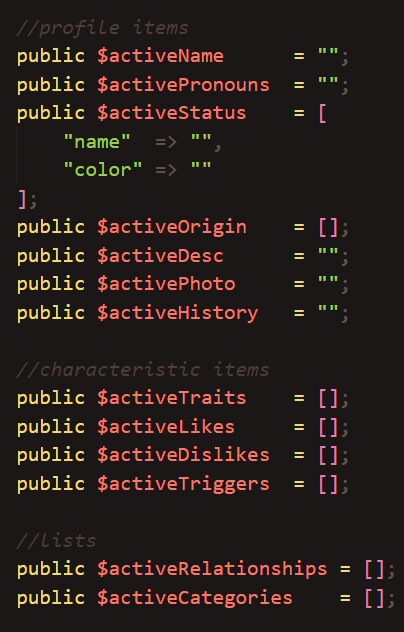
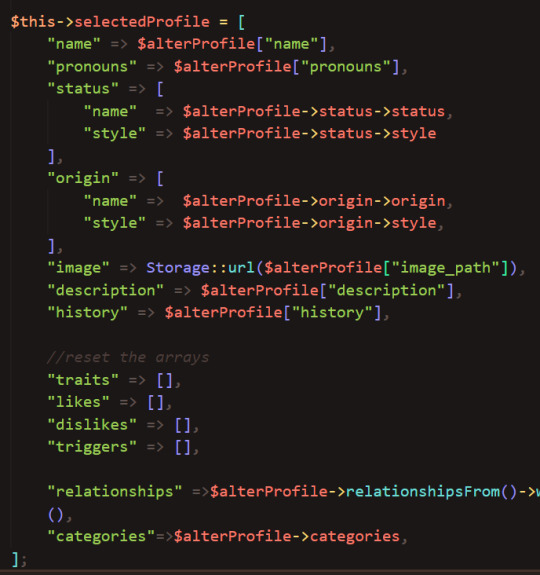
Design of the New Profile form
To be honest, I've been dreading this part since the beginning. I mean, how do I even lay this out? 💀
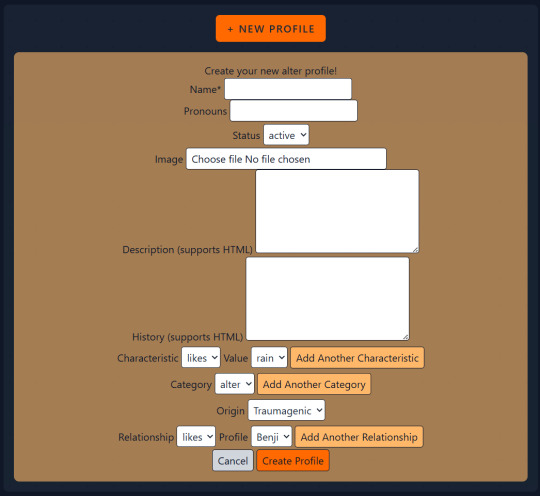
It is common for developers to avoid UI design because they are "coders not designers". I, for one, quite enjoy web design. Still, this task feels quite overwhelming to me. So, let's take this little mockup I made and turn it into something usable 💪
Too much stuff?
I think the biggest challenge here is the sheer number of inputs. And as the app grows, the number of inputs in this form will only increase.
The only mandatory input for a new profile is just their name. Therefore, the first step should be separating the Name field from the rest of the inputs.
The new and improved New Profile form is looking much better now:

...Yes, really! That's the whole form!
You are unlikely to know everything about an alter that has just split, so all those fields are completely unnecessary for an alter to be added to the list. Every other detail can be added later through the edit mode, where each field can be edited separately without needing one giant form.
Another big reason why I decided to forego the big form altogether is that the code for saving a new profile and the code for editing a profile would be almost exactly the same (including validation), and it wouldn't make sense to duplicate this code if I can just use it in one instance.
Saving a new profile
Let's add some validation to the input field to make sure that the user enters the name in a correct format.
As the Name is stored in the database as a string, it has the maximum length of 255 characters. Trying to save a longer name than this will cause errors, so we need to validate the input to make sure it's safe to insert into the database:

Here's what happens when I input a whole paragraph of Lorem Ipsum text and try to save it:

On the other hand, a shorter name saves just fine:

By the way, these flash messages are added in 2 ways: the success is a session message, and the error is an error stored separately by the validator. The flash messages originally have no styling, so I defined those myself using Tailwind's "@apply" for efficiency.
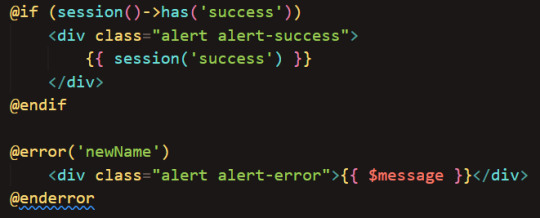
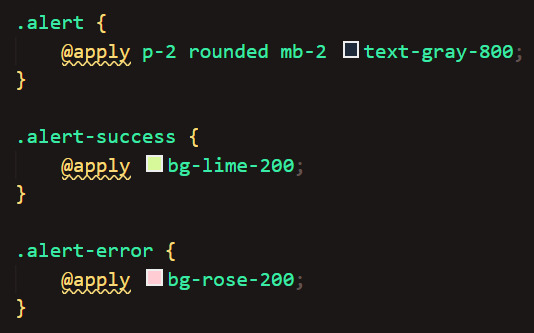
Once submitted, the name list automatically updates with our new profile:
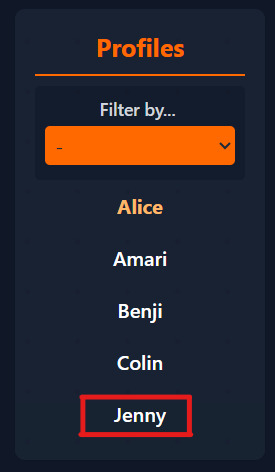
(And if I click cancel it just empties the input)

Okay, let's click on Jenny's profile to see what it looks like! ...Oh

This is because the code tries to access Jenny's status, but she doesn't have one yet, she only has a name!
(When I pull the data from the database, I'm trying to access a non-existent value)

(And when I display the values I got from the database, the display may break if the value is NULL)

(This error applies to all profile fields, not just status, however the app crashes after just the first error it comes across so the remaining errors are not shown)
This can easily fixed by using PHP's "isset()" and/or "empty()" function, which checks if a variable has a value:
(I'm using a ternary operator as a more compact alternative to if-else. it basically goes: "if this condition is true ? then do it : if not, do something else")

(And here I just check if these values are not blank before rendering them)

Success, Jenny's profile shows!
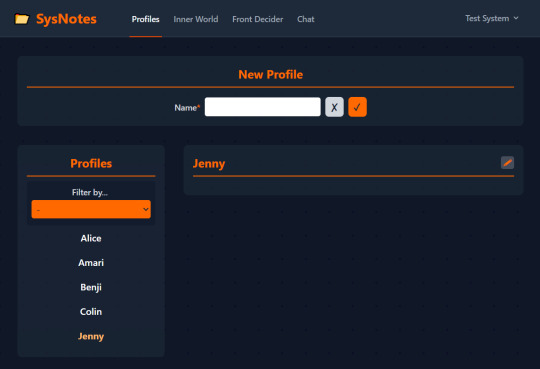
Now, we just have to populate this profile with data about Jenny, and to do that we'll need to be able to edit each field. I will work on this in the next devlog, as I expect this to take quite some time.
Thanks so reading! As always, any suggestions are welcome!
5 notes
·
View notes
Text
Computer Language
Computer languages, also known as programming languages, are formal languages used to communicate instructions to a computer. These instructions are written in a syntax that computers can understand and execute. There are numerous programming languages, each with its own syntax, semantics, and purpose. Here are some of the main types of programming languages:
1.Low-Level Languages:
Machine Language: This is the lowest level of programming language, consisting of binary code (0s and 1s) that directly corresponds to instructions executed by the computer's hardware. It is specific to the computer's architecture.
Assembly Language: Assembly language uses mnemonic codes to represent machine instructions. It is a human-readable form of machine language and closely tied to the computer's hardware architecture
2.High-Level Languages:
Procedural Languages: Procedural languages, such as C, Pascal, and BASIC, focus on defining sequences of steps or procedures to perform tasks. They use constructs like loops, conditionals, and subroutines.
Object-Oriented Languages: Object-oriented languages, like Java, C++, and Python, organize code around objects, which are instances of classes containing data and methods. They emphasize concepts like encapsulation, inheritance, and polymorphism.
Functional Languages: Functional languages, such as Haskell, Lisp, and Erlang, treat computation as the evaluation of mathematical functions. They emphasize immutable data and higher-order functions.
Scripting Languages: Scripting languages, like JavaScript, PHP, and Ruby, are designed for automating tasks, building web applications, and gluing together different software components. They typically have dynamic typing and are interpreted rather than compiled.
Domain-Specific Languages (DSLs): DSLs are specialized languages tailored to a specific domain or problem space. Examples include SQL for database querying, HTML/CSS for web development, and MATLAB for numerical computation.
3.Other Types:
Markup Languages: Markup languages, such as HTML, XML, and Markdown, are used to annotate text with formatting instructions. They are not programming languages in the traditional sense but are essential for structuring and presenting data.
Query Languages: Query languages, like SQL (Structured Query Language), are used to interact with databases by retrieving, manipulating, and managing data.
Constraint Programming Languages: Constraint programming languages, such as Prolog, focus on specifying constraints and relationships among variables to solve combinatorial optimization problems.
2 notes
·
View notes
Text
Exploring Essential Laravel Development Tools for Building Powerful Web Applications
Laravel has emerged as one of the most popular PHP frameworks, providing builders a sturdy and green platform for building net packages. Central to the fulfillment of Laravel tasks are the development tools that streamline the improvement process, decorate productiveness, and make certain code quality. In this article, we will delve into the best Laravel development tools that each developer should be acquainted with.
1 Composer: Composer is a dependency manager for PHP that allows you to declare the libraries your project relies upon on and manages them for you. Laravel itself relies closely on Composer for package deal management, making it an essential device for Laravel builders. With Composer, you may without problems upload, eliminate, or update applications, making sure that your Laravel project stays up-to-date with the present day dependencies.
2 Artisan: Artisan is the command-line interface blanketed with Laravel, presenting various helpful instructions for scaffolding, handling migrations, producing controllers, models, and plenty extra. Laravel builders leverage Artisan to automate repetitive tasks and streamline improvement workflows, thereby growing efficiency and productiveness.
3 Laravel Debugbar: Debugging is an crucial component of software program development, and Laravel Debugbar simplifies the debugging procedure by using supplying exact insights into the application's overall performance, queries, views, and greater. It's a accessible device for identifying and resolving problems all through improvement, making sure the clean functioning of your Laravel application.
4 Laravel Telescope: Similar to Laravel Debugbar, Laravel Telescope is a debugging assistant for Laravel programs, presenting actual-time insights into requests, exceptions, database queries, and greater. With its intuitive dashboard, developers can monitor the software's behavior, pick out performance bottlenecks, and optimize hence.
5 Laravel Mix: Laravel Mix offers a fluent API for outlining webpack build steps on your Laravel application. It simplifies asset compilation and preprocessing duties together with compiling SASS or LESS documents, concatenating and minifying JavaScript documents, and dealing with versioning. Laravel Mix significantly streamlines the frontend improvement procedure, permitting builders to attention on building notable consumer reviews.
6 Laravel Horizon: Laravel Horizon is a dashboard and configuration system for Laravel's Redis queue, imparting insights into process throughput, runtime metrics, and more. It enables builders to monitor and control queued jobs efficiently, ensuring most beneficial performance and scalability for Laravel programs that leverage history processing.
7 Laravel Envoyer: Laravel Envoyer is a deployment tool designed specifically for Laravel packages, facilitating seamless deployment workflows with 0 downtime. It automates the deployment process, from pushing code adjustments to more than one servers to executing deployment scripts, thereby minimizing the chance of errors and ensuring smooth deployments.
8 Laravel Dusk: Laravel Dusk is an cease-to-give up browser testing tool for Laravel applications, built on pinnacle of the ChromeDriver and WebDriverIO. It lets in builders to put in writing expressive and dependable browser assessments, making sure that critical user interactions and workflows function as expected across exceptional browsers and environments.
9 Laravel Valet: Laravel Valet gives a light-weight improvement surroundings for Laravel applications on macOS, offering seamless integration with equipment like MySQL, NGINX, and PHP. It simplifies the setup process, permitting developers to consciousness on writing code instead of configuring their development environment.
In end, mastering the vital Laravel development tools noted above is important for building robust, green, and scalable internet packages with Laravel. Whether it's handling dependencies, debugging troubles, optimizing overall performance, or streamlining deployment workflows, those equipment empower Laravel developers to supply outstanding answers that meet the demands of current internet development. Embracing these gear will certainly increase your Laravel improvement enjoy and accelerate your journey toward turning into a talented Laravel developer.
3 notes
·
View notes
Text
Top 10 Laravel Development Companies in the USA in 2024
Laravel is a widely-used open-source PHP web framework designed for creating web applications using the model-view-controller (MVC) architectural pattern. It offers developers a structured and expressive syntax, as well as a variety of built-in features and tools to enhance the efficiency and enjoyment of the development process.

Key components of Laravel include:
1. Eloquent ORM (Object-Relational Mapping): Laravel simplifies database interactions by enabling developers to work with database records as objects through a powerful ORM.
2. Routing: Laravel provides a straightforward and expressive method for defining application routes, simplifying the handling of incoming HTTP requests.
3. Middleware: This feature allows for the filtering of HTTP requests entering the application, making it useful for tasks like authentication, logging, and CSRF protection.
4. Artisan CLI (Command Line Interface): Laravel comes with Artisan, a robust command-line tool that offers commands for tasks such as database migrations, seeding, and generating boilerplate code.
5. Database Migrations and Seeding: Laravel's migration system enables version control of the database schema and easy sharing of changes across the team. Seeding allows for populating the database with test data.
6. Queue Management: Laravel's queue system permits deferred or background processing of tasks, which can enhance application performance and responsiveness.
7. Task Scheduling: Laravel provides a convenient way to define scheduled tasks within the application.
What are the reasons to opt for Laravel Web Development?
Laravel makes web development easier, developers more productive, and web applications more secure and scalable, making it one of the most important frameworks in web development.
There are multiple compelling reasons to choose Laravel for web development:
1. Clean and Organized Code: Laravel provides a sleek and expressive syntax, making writing and maintaining code simple. Its well-structured architecture follows the MVC pattern, enhancing code readability and maintainability.
2. Extensive Feature Set: Laravel comes with a wide range of built-in features and tools, including authentication, routing, caching, and session management.
3. Rapid Development: With built-in templates, ORM (Object-Relational Mapping), and powerful CLI (Command Line Interface) tools, Laravel empowers developers to build web applications quickly and efficiently.
4. Robust Security Measures: Laravel incorporates various security features such as encryption, CSRF (Cross-Site Request Forgery) protection, authentication, and authorization mechanisms.
5. Thriving Community and Ecosystem: Laravel boasts a large and active community of developers who provide extensive documentation, tutorials, and forums for support.
6. Database Management: Laravel's migration system allows developers to manage database schemas effortlessly, enabling version control and easy sharing of database changes across teams. Seeders facilitate the seeding of databases with test data, streamlining the testing and development process.
7. Comprehensive Testing Support: Laravel offers robust testing support, including integration with PHPUnit for writing unit and feature tests. It ensures that applications are thoroughly tested and reliable, reducing the risk of bugs and issues in production.
8. Scalability and Performance: Laravel provides scalability options such as database sharding, queue management, and caching mechanisms. These features enable applications to handle increased traffic and scale effectively.
Top 10 Laravel Development Companies in the USA in 2024
The Laravel framework is widely utilised by top Laravel development companies. It stands out among other web application development frameworks due to its advanced features and development tools that expedite web development. Therefore, this article aims to provide a list of the top 10 Laravel Development Companies in 2024, assisting you in selecting a suitable Laravel development company in the USA for your project.
IBR Infotech

IBR Infotech excels in providing high-quality Laravel web development services through its team of skilled Laravel developers. Enhance your online visibility with their committed Laravel development team, which is prepared to turn your ideas into reality accurately and effectively. Count on their top-notch services to receive the best as they customise solutions to your business requirements. Being a well-known Laravel Web Development Company IBR infotech is offering the We provide bespoke Laravel solutions to our worldwide customer base in the United States, United Kingdom, Europe, and Australia, ensuring prompt delivery and competitive pricing.
Additional Information-
GoodFirms : 5.0
Avg. hourly rate: $25 — $49 / hr
No. Employee: 10–49
Founded Year : 2014
Verve Systems
Elevate your enterprise with Verve Systems' Laravel development expertise. They craft scalable, user-centric web applications using the powerful Laravel framework. Their solutions enhance consumer experience through intuitive interfaces and ensure security and performance for your business.
Additional Information-
GoodFirms : 5.0
Avg. hourly rate: $25
No. Employee: 50–249
Founded Year : 2009
KrishaWeb

KrishaWeb is a world-class Laravel Development company that offers tailor-made web solutions to our clients. Whether you are stuck up with a website concept or want an AI-integrated application or a fully-fledged enterprise Laravel application, they can help you.
Additional Information-
GoodFirms : 5.0
Avg. hourly rate: $50 - $99/hr
No. Employee: 50 - 249
Founded Year : 2008
Bacancy
Bacancy is a top-rated Laravel Development Company in India, USA, Canada, and Australia. They follow Agile SDLC methodology to build enterprise-grade solutions using the Laravel framework. They use Ajax-enabled widgets, model view controller patterns, and built-in tools to create robust, reliable, and scalable web solutions
Additional Information-
GoodFirms : 4.8
Avg. hourly rate: $25 - $49/hr
No. Employee: 250 - 999
Founded Year : 2011
Elsner
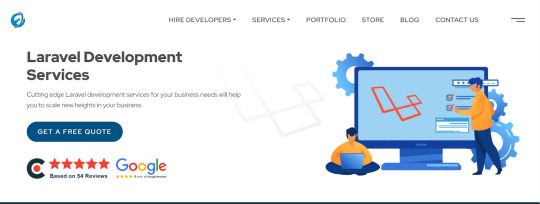
Elsner Technologies is a Laravel development company that has gained a high level of expertise in Laravel, one of the most popular PHP-based frameworks available in the market today. With the help of their Laravel Web Development services, you can expect both professional and highly imaginative web and mobile applications.
Additional Information-
GoodFirms : 5
Avg. hourly rate: < $25/hr
No. Employee: 250 - 999
Founded Year : 2006
Logicspice

Logicspice stands as an expert and professional Laravel web development service provider, catering to enterprises of diverse scales and industries. Leveraging the prowess of Laravel, an open-source PHP framework renowned for its ability to expedite the creation of secure, scalable, and feature-rich web applications.
Additional Information-
GoodFirms : 5
Avg. hourly rate: < $25/hr
No. Employee: 50 - 249
Founded Year : 2006
Sapphire Software Solutions
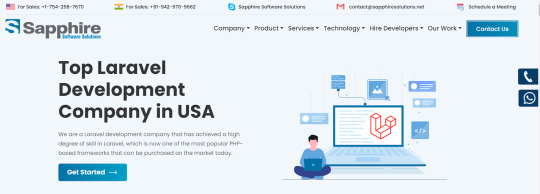
Sapphire Software Solutions, a leading Laravel development company in the USA, specialises in customised Laravel development, enterprise solutions,.With a reputation for excellence, they deliver top-notch services tailored to meet your unique business needs.
Additional Information-
GoodFirms : 5
Avg. hourly rate: NA
No. Employee: 50 - 249
Founded Year : 2002
iGex Solutions
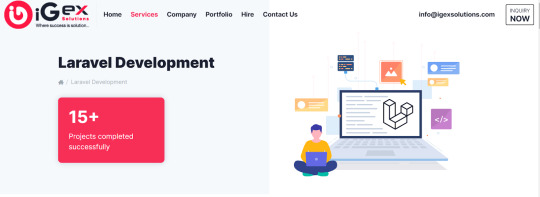
iGex Solutions offers the World’s Best Laravel Development Services with 14+ years of Industry Experience. They have 10+ Laravel Developer Experts. 100+ Elite Happy Clients from there Services. 100% Client Satisfaction Services with Affordable Laravel Development Cost.
Additional Information-
GoodFirms : 4.7
Avg. hourly rate: < $25/hr
No. Employee: 10 - 49
Founded Year : 2009
Hidden Brains
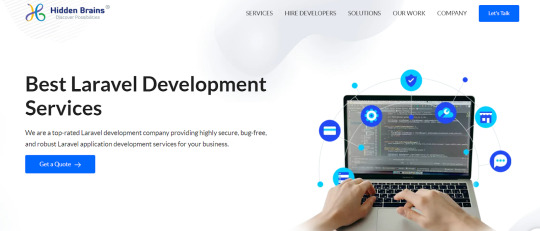
Hidden Brains is a leading Laravel web development company, building high-performance Laravel applications using the advantage of Laravel's framework features. As a reputed Laravel application development company, they believe your web application should accomplish the goals and can stay ahead of the rest.
Additional Information-
GoodFirms : 4.9
Avg. hourly rate: < $25/hr
No. Employee: 250 - 999
Founded Year : 2003
Matellio
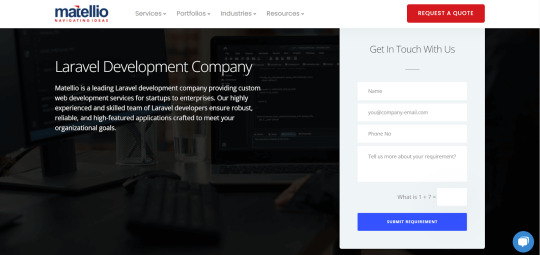
At Matellio, They offer a wide range of custom Laravel web development services to meet the unique needs of their global clientele. There expert Laravel developers have extensive experience creating robust, reliable, and feature-rich applications
Additional Information-
GoodFirms : 4.8
Avg. hourly rate: $50 - $99/hr
No. Employee: 50 - 249
Founded Year : 2014
What advantages does Laravel offer for your web application development?
Laravel, a popular PHP framework, offers several advantages for web application development:
Elegant Syntax
Modular Packaging
MVC Architecture Support
Database Migration System
Blade Templating Engine
Authentication and Authorization
Artisan Console
Testing Support
Community and Documentation
Conclusion:
I hope you found the information provided in the article to be enlightening and that it offered valuable insights into the top Laravel development companies.
These reputable Laravel development companies have a proven track record of creating customised solutions for various sectors, meeting client requirements with precision.
Over time, these highlighted Laravel developers for hire have completed numerous projects with success and are well-equipped to help advance your business.
Before finalising your choice of a Laravel web development partner, it is essential to request a detailed cost estimate and carefully examine their portfolio of past work.
#Laravel Development Companies#Laravel Development Companies in USA#Laravel Development Company#Laravel Web Development Companies#Laravel Web Development Services
2 notes
·
View notes
Text
The most special cars presented at the Tokyo Motor Show
After a four-year absence, the Tokyo Auto Show is coming back in force in 2023, under a new name: Japan Mobility Show and the PHP Rent a Car Cluj Napoca Airport rental office announces that this change of identity reflects the organizers' decision to expand the attraction event and increase participation by including auto component suppliers, technology companies, and transportation devices other than cars such as mopeds, bicycles, and electric scooters, among others. However, the event itself looks set to be one of the most exciting convention auto shows in recent years, full of bold concepts and enthusiast cars, some of which are destined for series production:
https://www.phprentacar.ro/en/b-the-most-special-cars-presented-at-the-tokyo-motor-show





4 notes
·
View notes
Text
JavaScript Frameworks
Step 1) Polyfill
Most JS frameworks started from a need to create polyfills. A Polyfill is a js script that add features to JavaScript that you expect to be standard across all web browsers. Before the modern era; browsers lacked standardization for many different features between HTML/JS/and CSS (and still do a bit if you're on the bleeding edge of the W3 standards)
Polyfill was how you ensured certain functions were available AND worked the same between browsers.
JQuery is an early Polyfill tool with a lot of extra features added that makes JS quicker and easier to type, and is still in use in most every website to date. This is the core standard of frameworks these days, but many are unhappy with it due to performance reasons AND because plain JS has incorporated many features that were once unique to JQuery.
JQuery still edges out, because of the very small amount of typing used to write a JQuery app vs plain JS; which saves on time and bandwidth for small-scale applications.
Many other frameworks even use JQuery as a base library.
Step 2) Encapsulated DOM
Storing data on an element Node starts becoming an issue when you're dealing with multiple elements simultaneously, and need to store data as close as possible to the DOMNode you just grabbed from your HTML, and probably don't want to have to search for it again.
Encapsulation allows you to store your data in an object right next to your element so they're not so far apart.
HTML added the "data-attributes" feature, but that's more of "loading off the hard drive instead of the Memory" situation, where it's convenient, but slow if you need to do it multiple times.
Encapsulation also allows for promise style coding, and functional coding. I forgot the exact terminology used,but it's where your scripting is designed around calling many different functions back-to-back instead of manipulating variables and doing loops manually.
Step 3) Optimization
Many frameworks do a lot of heavy lifting when it comes to caching frequently used DOM calls, among other data tools, DOM traversal, and provides standardization for commonly used programming patterns so that you don't have to learn a new one Everytime you join a new project. (you will still have to learn a new one if you join a new project.)
These optimizations are to reduce reflowing/redrawing the page, and to reduce the plain JS calls that are performance reductive. A lot of these optimatizations done, however, I would suspect should just be built into the core JS engine.
(Yes I know it's vanilla JS, I don't know why plain is synonymous with Vanilla, but it feels weird to use vanilla instead of plain.)
Step 4) Custom Element and component development
This was a tool to put XML tags or custom HTML tags on Page that used specific rules to create controls that weren't inherent to the HTML standard. It also helped linked multiple input and other data components together so that the data is centrally located and easy to send from page to page or page to server.
Step 5) Back-end development
This actually started with frameworks like PHP, ASP, JSP, and eventually resulted in Node.JS. these were ways to dynamically generate a webpage on the server in order to host it to the user. (I have not seen a truly dynamic webpage to this day, however, and I suspect a lot of the optimization work is actually being lost simply by programmers being over reliant on frameworks doing the work for them. I have made this mistake. That's how I know.)
The backend then becomes disjointed from front-end development because of the multitude of different languages, hence Node.JS. which creates a way to do server-side scripting in the same JavaScript that front-end developers were more familiar with.
React.JS and Angular 2.0 are more of back end frameworks used to generate dynamic web-page without relying on the User environment to perform secure transactions.
Step 6) use "Framework" as a catch-all while meaning none of these;
Polyfill isn't really needed as much anymore unless your target demographic is an impoverished nation using hack-ware and windows 95 PCs. (And even then, they could possible install Linux which can use modern lightweight browsers...)
Encapsulation is still needed, as well as libraries that perform commonly used calculations and tasks, I would argue that libraries aren't going anywhere. I would also argue that some frameworks are just bloat ware.
One Framework I was researching ( I won't name names here) was simply a remapping of commands from a Canvas Context to an encapsulated element, and nothing more. There was literally more comments than code. And by more comments, I mean several pages of documentation per 3 lines of code.
Custom Components go hand in hand with encapsulation, but I suspect that there's a bit more than is necessary with these pieces of frameworks, especially on the front end. Tho... If it saves a lot of repetition, who am I to complain?
Back-end development is where things get hairy, everything communicates through HTTP and on the front end the AJAX interface. On the back end? There's two ways data is given, either through a non-html returning web call, *or* through functions that do a lot of heavy lifting for you already.
Which obfuscates how the data is used.
But I haven't really found a bad use of either method. But again; I suspect many things about performance impacts that I can't prove. Specifically because the tools in use are already widely accepted and used.
But since I'm a lightweight reductionist when it comes to coding. (Except when I'm not because use-cases exist) I can't help but think most every framework work, both front-end and Back-end suffers from a lot of bloat.
And that bloat makes it hard to select which framework would be the match for the project you're working on. And because of that; you could find yourself at the tail end of a development cycle realizing; You're going to have to maintain this as is, in the exact wrong solution that does not fit the scope of the project in anyway.
Well. That's what junior developers are for anyway...
2 notes
·
View notes
Text
People I'd like to know better
I was tagged by my amazing friend @helenofsimblr thank you hun
Last Song: Shadowmaker by Apocalyptica
Favorite Color: black, purple and shades of them
Currently Watching: Lies of P yt gameplay
Last Movie: King of Killers (I don't even know why)
Currently Reading: php guides
Sweet/Spicy/Savory: Savory/salt
Last Thing I Googled: computers components
Current Obsession: Eminem, rpg games and computer stuff
And that's all folks!!
I tag anyone who wants to do it 😛
4 notes
·
View notes
Text
The Future of Full Stack Development: Envisioning Cutting-edge Trends and Innovations
In the rapidly evolving digital era, the concept of full stack development has emerged as a critical component for modern businesses. Embracing full stack development means embracing the ability to handle both frontend and backend development tasks, effortlessly bridging the gap between different layers of technology. By having a holistic understanding of all aspects of software development, full stack developers hold the key to unlocking innovation, efficiency, and adaptability in the tech industry.
Staying ahead of the curve is imperative for any developer, and full stack development plays a vital role in enabling professionals to do just that. In this article, we will explore the realm of full stack development, its evolution over time, and the cutting-edge trends and innovations that are shaping its future.

II. Understanding Full Stack Development
Defining full stack development and its evolution over time
Full stack development refers to the practice of handling both frontend and backend development tasks, making developers proficient in multiple technologies. While the term "full stack" was initially coined to describe web development, its scope has expanded to encompass a broader variety of technologies and platforms, including mobile applications.
Throughout its evolution, full stack development has transformed from being focused on traditional web development stacks to embracing modern and versatile frameworks. This shift has allowed developers to have a more comprehensive understanding of the entire software development process.
Importance of full stack developers in today's tech industry
The demand for full stack developers has soared in recent years, primarily due to their ability to handle various development tasks efficiently. Full stack developers possess a unique skill set that allows them to contribute to different stages of the development lifecycle, making them highly sought after by organizations looking to streamline their processes.
By being capable of working on both the frontend and backend, full stack developers bring synergy to teams, facilitating seamless collaboration and reducing the need for heavy dependencies on specialized roles. Their versatility empowers organizations to innovate rapidly and respond effectively to changing market demands.
III. The Evolution of Full Stack Development
Early days: Traditional web development stacks
In the early days of full stack development, traditional web development stacks like LAMP (Linux, Apache, MySQL, PHP) and WAMP (Windows, Apache, MySQL, PHP) dominated the scene. These stacks provided developers with the foundations to build dynamic and interactive websites, integrating various frontend elements with backend functionalities.
Shifting to modern stacks: MEAN, MERN, and more
As web technologies evolved, modern full stack development stacks like MEAN (MongoDB, Express.js, Angular, Node.js) and MERN (MongoDB, Express.js, React, Node.js) emerged. These stacks capitalized on the power of JavaScript to provide developers with a unified language for both frontend and backend development. These modern stacks enable rapid development and enhance code reusability and maintainability.
The rise of versatile frameworks and libraries
The continuous innovation in the tech industry has given rise to versatile frameworks and libraries that augment the capabilities of full stack developers. Frameworks like Laravel, Ruby on Rails, and Django simplify backend development, while frontend frameworks like React, Angular, and Vue.js provide efficient solutions for creating dynamic user interfaces. These frameworks, combined with powerful libraries like Redux and Bootstrap, empower full stack developers to create robust, user-friendly, and visually appealing applications.
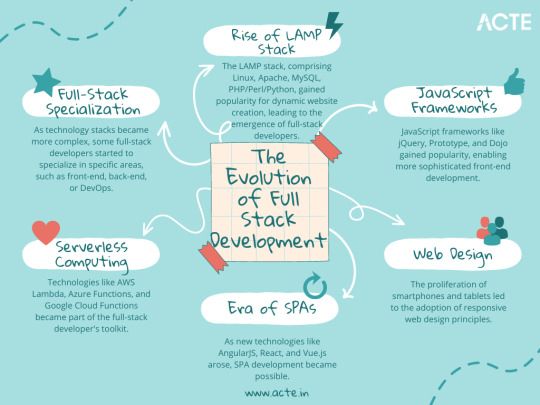
IV. Key Technologies Shaping the Future of Full Stack Development
Artificial Intelligence and Machine Learning integration
Artificial Intelligence (AI) and Machine Learning (ML) are revolutionizing full stack development by enabling developers to create intelligent and data-driven applications. Integration of AI and ML technologies into full stack development empowers applications to analyze vast amounts of data, make informed decisions, and provide personalized experiences to users.
Blockchain technology and its impact on full stack development
Blockchain technology is another key innovation that is transforming the landscape of full stack development. Its decentralized and immutable nature brings enhanced security, transparency, and traceability to applications. Full stack developers are leveraging blockchain to build secure and trustless applications for various industries, such as finance, supply chain, and healthcare.
Augmented Reality/Virtual Reality and its potential applications
Augmented Reality (AR) and Virtual Reality (VR) are emerging technologies that hold immense potential for full stack development. These technologies offer unique opportunities to create immersive and engaging user experiences. Full stack developers can harness AR and VR to build applications for gaming, training simulations, virtual tours, and other interactive experiences.
V. Exploring Advanced Front-end Development
Progressive Web Apps and their advantages
Progressive Web Apps (PWAs) are a cutting-edge advancement in full stack development that combines the best features of web and mobile applications. PWAs offer fast and reliable performance, offline capabilities, and push notifications, providing users with an app-like experience directly from their browsers. Full stack developers can leverage frameworks like React and Angular to build PWAs that support cross-platform compatibility and deliver seamless user experiences.
The role of JavaScript frameworks: React, Angular, Vue.js
React, Angular, and Vue.js are a few examples of JavaScript frameworks that have completely changed front-end development.These frameworks provide developers with the tools and components necessary to build interactive and responsive user interfaces. Full stack developers proficient in these frameworks can create dynamic web applications and enhance user experiences with ease.
WebAssembly: Unlocking high-performance web applications
WebAssembly (WASM) is an innovative technology that allows full stack developers to run high-performance applications directly in the browser. With WebAssembly, developers can compile languages like C, C++, and Rust into a binary format that can execute at near-native speeds. This capability enhances the performance and versatility of web applications, opening up new possibilities for full stack development.
VI. Innovative Back-end Developments
Serverless architecture and its benefits
Serverless architecture is transforming the way backend development is approached. With serverless computing, full stack developers can focus more on the core functionality of their applications, without the need to manage the infrastructure. Serverless platforms like AWS Lambda and Azure Functions provide scalability, cost efficiency, and ease of deployment, allowing developers to build and deploy applications more rapidly.
Microservices: Enhancing scalability and flexibility
Microservices architecture is gaining popularity in full stack development due to its ability to enhance scalability and flexibility. By breaking down applications into smaller, modular services, full stack developers can independently develop, test, deploy, and scale different components of the application. Microservices enable teams to collaborate more effectively, improve fault tolerance, and achieve faster time-to-market.
Containerization: Docker and Kubernetes revolution
Containerization has revolutionized the deployment and management of applications. Docker, combined with orchestration tools like Kubernetes, allows full stack developers to package applications along with their dependencies into lightweight and portable containers. This approach enables seamless deployment across different environments and simplifies scaling and maintenance, making it a preferred choice for modern full stack development.
VII. The Convergence of DevOps and Full Stack Development
Understanding the collaboration between developers and operations
DevOps has emerged as a crucial discipline that emphasizes seamless collaboration between development and operations teams. In the context of full stack development, this collaboration becomes even more critical, as developers are responsible for both frontend and backend operations. By adopting DevOps principles, full stack developers can streamline processes, accelerate delivery, and maintain a high level of quality in their applications.
Continuous Integration and Continuous Delivery (CI/CD) pipelines
Continuous Integration (CI) and Continuous Delivery (CD) pipelines are fundamental practices for full stack development teams. CI/CD pipelines automate the process of integrating code changes, running tests, and delivering applications to production environments. By embracing CI/CD pipelines, full stack developers can ensure faster, more frequent releases while maintaining the stability and quality of their applications.
Infrastructure as Code (IaC) practices
Infrastructure as Code (IaC) is a key practice that enables full stack developers to manage infrastructure programmatically, treating it as code. Using tools like Terraform and CloudFormation, developers can define and provision infrastructure resources declaratively. This approach enhances scalability, reproducibility, and consistency, and reduces the chances of manual errors, making infrastructure management more efficient and reliable.
VIII. The Impact of Cloud Computing on Full Stack Development
Cloud-native development: Advantages and challenges
Cloud computing has transformed the landscape of full stack development. Full stack developers can leverage cloud platforms like AWS, Azure, and Google Cloud to build scalable, reliable, and cost-effective applications. Cloud-native development allows developers to take advantage of cloud services, such as storage, databases, and machine learning, without the need for extensive infrastructure management. However, challenges related to security, vendor lock-in, and latency must be carefully addressed when adopting cloud-native approaches.
Leveraging Platform-as-a-Service (PaaS) solutions
Platform-as-a-Service (PaaS) solutions offer full stack developers a simplified and streamlined environment to develop, deploy, and manage applications. PaaS platforms, like Heroku, Cloud Foundry, and Google App Engine, abstract away the underlying infrastructure, allowing developers to focus solely on application logic. PaaS solutions accelerate development cycles, remove the burden of infrastructure management, and enable developers to iterate quickly.
Serverless computing and its implications
Serverless computing, offered by cloud providers such as AWS Lambda and Azure Functions, has gained significant attention in recent years. With serverless computing, full stack developers can focus on writing small, event-driven functions that automatically scale based on demand. This approach significantly reduces operational overhead, improves resource utilization, and allows developers to build highly scalable and cost-efficient applications.
IX. Full Stack Development for Mobile Applications
Native vs. Cross-platform development
When it comes to mobile application development, full stack developers face the choice between native and cross-platform development. Native development involves building applications specifically for a particular platform, such as iOS or Android, using platform-specific programming languages. Cross-platform development, on the other hand, allows developers to write code once and deploy it on multiple platforms. While native development offers maximum performance and access to platform-specific features, cross-platform development provides greater code reusability and faster development cycles.
Mobile frameworks: React Native and Flutter
React Native and Flutter are two popular mobile frameworks that have gained significant traction in the full stack development community. React Native, based on JavaScript, and Flutter, based on Dart, provide the ability to build high-quality native mobile applications using a single codebase. These frameworks offer reusable components, hot reloading, and a rich ecosystem of libraries and tools, empowering full stack developers to create stunning and performant mobile apps rapidly.
Mobile web development: Challenges and opportunities
Mobile web development enables full stack developers to create web applications optimized for mobile devices. While this approach provides the advantage of platform independence and ease of maintenance, it poses challenges like limited access to device features and potential performance limitations. However, leveraging responsive design, progressive enhancements, and caching mechanisms, full stack developers can overcome these challenges and deliver seamless mobile experiences through web applications.
X. The Future of User Experience (UX) in Full Stack Development
Voice User Interfaces (VUIs) and Natural Language Processing (NLP)
Voice User Interfaces (VUIs) and Natural Language Processing (NLP) are transforming the way users interact with applications. With advancements in technologies like Speech Recognition and Natural Language Understanding, full stack developers can build applications that respond to voice commands and understand natural language. By integrating VUIs and NLP, developers can provide intuitive, hands-free user experiences, enabling better accessibility and increased user engagement.
Augmented Reality (AR) and User Interface (UI) integration
Augmented Reality (AR) is reshaping the user experience landscape by overlaying virtual content onto the physical world. Full stack developers can fuse AR technology with user interfaces, creating interactive and immersive experiences. By integrating AR into applications, developers can enhance visualization, spatial awareness, and engagement, opening up new possibilities in areas such as gaming, retail, and education.
Intelligent chatbots and personalized user experiences
Intelligent chatbots powered by Artificial Intelligence (AI) are becoming increasingly prevalent in applications. Full stack developers can leverage AI technologies like Natural Language Processing and Machine Learning to create chatbots capable of understanding user intents and providing personalized responses. By incorporating chatbots into applications, developers can automate customer support, improve user interactions, and deliver tailored experiences at scale.
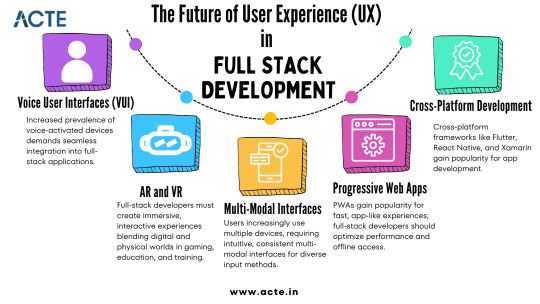
XI. Security Considerations in Full Stack Development
Protecting applications against data breaches and cyberattacks
The most important consideration in full stack development is security. Developers that work across the entire stack must be well-versed in secure coding techniques and have a solid grasp of typical vulnerabilities and attack vectors. Developers may safeguard apps against data breaches and cyberattacks, protecting user information and preserving the integrity of the systems they create, by integrating secure authentication mechanisms, input validation, encryption methods, and routine security audits.
Implementing secure coding practices
Secure coding practices are essential to mitigate security risks in full stack development. Developers must adhere to industry best practices, such as validating user inputs, using parameterized queries to prevent SQL injection, and employing access control mechanisms to ensure proper authorization. By following secure coding principles, full stack developers can minimize the likelihood of introducing vulnerabilities and maintain the confidentiality, integrity, and availability of applications.
Incorporating encryption and authentication mechanisms
Encryption and authentication mechanisms play a critical role in securing full stack applications. Full stack developers should implement encryption protocols like SSL/TLS to protect data transmission and storage. Additionally, robust authentication mechanisms, such as multi-factor authentication and OAuth, should be utilized to ensure that only authorized users can access sensitive resources. By incorporating these security measures, developers can fortify applications against unauthorized access and data breaches.
XII. Scaling Full Stack Applications for the Modern Era
Horizontal and vertical scaling: Pros and cons
Scaling is a fundamental aspect of full stack development to ensure applications can handle increased user demand. Full stack developers can choose between horizontal scaling, which involves adding more instances of servers to distribute the workload, and vertical scaling, which involves increasing the resources of existing servers. Horizontal scaling provides better fault tolerance and can handle rapid spikes in traffic, while vertical scaling offers better performance and reduced overhead. Choosing the appropriate scaling strategy depends on the unique requirements and architecture of the application.
Optimizing performance with caching and load balancing
Optimizing performance is crucial in full stack development. By implementing caching mechanisms, such as Content Delivery Networks (CDNs) and in-memory caching, full stack developers can minimize server response times and reduce the load on the backend infrastructure. Additionally, load balancing techniques distribute traffic across multiple servers, preventing overload and ensuring optimal performance. By leveraging caching and load balancing strategies, developers can improve scalability, reliability, and user experience.
Monitoring and error handling strategies
The vitality and stability of full stack applications depend on monitoring and error management. Full stack developers should use reliable monitoring tools that offer in-the-moment visibility into the performance, resource usage, and any problems of the application. Developers can proactively discover and address issues by utilizing logging, alerting, and automated error handling techniques, which reduces downtime and improves the user experience overall.
XIII. Learning Resources
Given that there is so much to learn and comprehend, staying current with the most recent full stack development trends and breakthroughs can be a challenging undertaking. Fortunately, there are many tools at their disposal to assist developers in keeping up with the most recent developments and technology. These sources include blogs, books, tutorials, and Full Stack Developer courses.

In conclusion, any software developer must stay current with the most recent trends and advances because full stack development is a field that is continuously changing in order to produce better, more effective solutions. We have examined some of the most recent full stack development trends and innovations in this blog, including low-code/no-code development, automation, artificial intelligence, open source platforms, cloud-based solutions, cross-platform development, containers, blockchain development, GraphQL, data-driven solutions, augmented reality, and virtual reality applications. There are several resources accessible for those who want to learn more about full stack development, including online courses, tutorials, books, and blogs.
6 notes
·
View notes